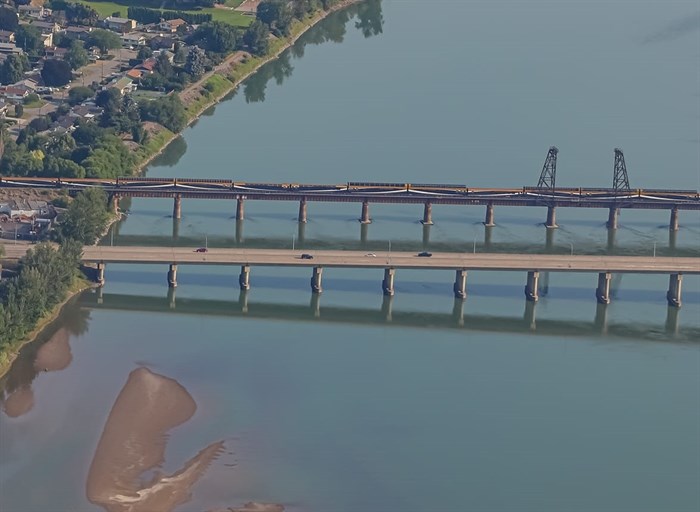
The CNR North Thompson bridge and Halston Bridge in Kamloops are pictured in this aerial photo taken in the summer of 2023.
Image Credit: SUBMITTED/ Lucas Cain
June 09, 2024 - 6:30 AM
Kamloops commuters drive past the CN railroad bridge that spans the North Thompson River every day, but some might not know the bridge holds a unique claim to fame.
Built in 1914, the railroad's North Thompson bridge was the first vertical lift rail bridge in Canada, and the third of its kind in North America.
Running parallel to the Halston Bridge and its heavy traffic, the railway bridge has two noticeable towers sticking up from its centre. These were once part of a pulley system used to lift a span of bridge to allow for the passage of commercial river boats.
The moveable span was 93-feet long and could be lifted 55 feet above the high water mark, according to a 1993 article written by David Davies and provided to iNFOnews.ca by the Kamloops Museum and Archives.
The span was held by two towers and connected to two 59-ton concrete counterweights by cables that ran over pulleys on the tops of the towers. The operation was powered by a gasoline engine underneath the centre of the track.
Kamloops sits on a waterway that runs from Enderby to Savona, and according to the archive both the Canadian Pacific Railway and the Canadian Northern Railway, or CNoR, were forced by the federal government to build two moving bridges over the North and South Thompson Rivers in order to cross it.
The waterway was plied commercially by steamboats between 1866 and 1914, and a stretch was used briefly by one sternwheeler between 1933 and 1948.
“This must have upset the Company because it knew the days of navigation on the North Thompson River were coming to an end, hastened by the very arrival of its own railway,” the article read. “The introduction of a moveable span to a bridge complicates its design and certainly adds to its costs.”
READ MORE: How Europeans distorted the true names of Kamloops and the Okanagan
The South Thompson River was bridged three times at the same location by what is now Riverside Park. The first bridge had a temporary and fixed span, and the swing design was used for the last two bridges.
The current version of the rail bridge over the South Thompson River is a steel girder bridge with a 208-feet swing span built in 1927 by Coughlin Steel Ltd, a Vancouver firm that had fabricated steel and built merchant ships during the First World War.
“From the date of its construction to 1985 the draw span was rarely used and was swung once a year in a ritual to show that navigation rights were being preserved and to test the machinery,” the article read.
READ MORE: The long history of paddle wheelers between Kamloops and Enderby
“In that year the tourist sternwheeler Wanda Sue commenced thrice weekly runs to the head of Kamloops Lake and this necessitated opening the bridge, a practise that has continued since.”
The vertical lift span on the CNR North Thompson bridge wasn’t used very often and in 1937, the railway was permitted by the federal government to remove the counterweight and bolt the lifting span into a permanent position, however, the towers remain today.
To contact a reporter for this story, email Shannon Ainslie or call 250-819-6089 or email the editor. You can also submit photos, videos or news tips to the newsroom and be entered to win a monthly prize draw.
We welcome your comments and opinions on our stories but play nice. We won't censor or delete comments unless they contain off-topic statements or links, unnecessary vulgarity, false facts, spam or obviously fake profiles. If you have any concerns about what you see in comments, email the editor in the link above. SUBSCRIBE to our awesome newsletter here.
News from © iNFOnews, 2024